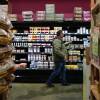Gone are the days of serving up tater tots and French toast sticks to students. Here are the days of carrot sticks and quinoa.
New nutritional guidelines, announced in 2012, require public school lunchrooms to offer more whole grains, low-fat milk and fewer starchy sides like french fries. But short of stationing grandmothers in every cafeteria, how do you ensure that students actually eat the fruits and veggies they're being offered?
A minor lunchroom makeover could make a big difference, says Andrew Hanks, a behavioral economist at Cornell University.
In a study published online by The Journal of Pediatrics, Hanks and his colleagues David Just and Brian Wansink, at the Cornell Center for Behavioral Economics in Child Nutrition Programs, demonstrate that small, simple changes in presentation and layout can have a large impact on how — and what — students eat.
Wheel the salad bar into a high-traffic area, for example, and place an attractive fruit basket next to the register. Stock juice popsicles alongside ice cream in the freezer, and have the cafeteria staff gently "up-sell" fruits and vegetables – for example, by asking, "Would you like to try an apple?"
"The whole premise behind this is that, as consumers, we have behavioral biases that lead us to make certain decisions," Hanks tells The Salt. "If a food is more convenient to reach in a lunch line or store, "we'll probably take that over a close substitute. If the cookies are easier to reach than the apple, you're probably going to take the cookie."
Similar product-placement tactics have proved effective at getting grocery store shoppers to buy more produce. And amid rising childhood obesity rates, there's been a surge of interest in recent years in applying lessons from behavioral economics to getting kids to make better choices in the lunchroom.
Hanks spent two weeks in New York junior high schools, observing students' dietary choices before and after what he calls a "smart lunchroom" makeover. The makeover required three hours and cost less than $50.
Standing at the register and near the garbage cans, Hanks counted some 3,700 trays, noting both what students piled on their plates and what they actually consumed. "You've got to get your hands dirty, literally," he says. "Our mantra is, 'It's not nutrition until it's eaten.' "
In a "smart" lunchroom, the authors found, students were 13 to 23 percent more likely to take a fruit or vegetable, and 10 to 15 percent more likely to eat the whole thing.
"What's important is that kids are taking things of their own volition," Hanks says. "It's going to increase the amount they're actually eating."
This is a tactic behavioral economists call "libertarian paternalism," a term coined in the early aughts by the University of Chicago's Richard Thaler and Cass Sunstein. Impel students to take boiled spinach by slopping it on their plates, and it'll be scraped straight into the garbage. Encourage them to take the veggie with a subtle nudge — no ultimatum, no "Because I say so" — and chances are they'll actually eat it.
"The idea of libertarian paternalism is that we're not forcing behavior," says Hanks. "We're not restricting choices or making kids have carrots on their trays. We're preserving choice but guiding better behavior."
Nicola Edwards, a dietitian with California Food Policy Advocates, agrees that the real challenge is motivating students to actually eat the healthful food once it's on their plates. Edwards is working on an initiative known as Real Eats for Academics and Life, dedicated to making lunches more appealing in Los Angeles school districts. L.A. students, you might recall, made headlines in 2011 for roundly rejecting revamped lunch menus featuring healthful options like quinoa salads.
"Surveys and interviews with students have told us that when something looks like it's been freshly prepared and not overly packaged, they find it more appealing and are more likely to consume it," she says.
Edwards also discovered that students are more likely to eat a vegetable if it's served as an ingredient in an entrée — rather than as a side — and that young children prefer bite-sized apple slices to whole fruit. Such ideas are now getting trial runs in some L.A. schools.
But, Edwards adds, "We also know that change doesn't happen overnight. Kids aren't going to go from pizza one day to quinoa the next."
To that end, Cornell's Smarter Lunchrooms Movement has pioneered other ways to improve student diet, such as emailing nutrition report cards to mom and dad ("Here's what your child picked today"), or having students "pre-order" lunch.
Copyright 2016 NPR. To see more, visit http://www.npr.org/.



